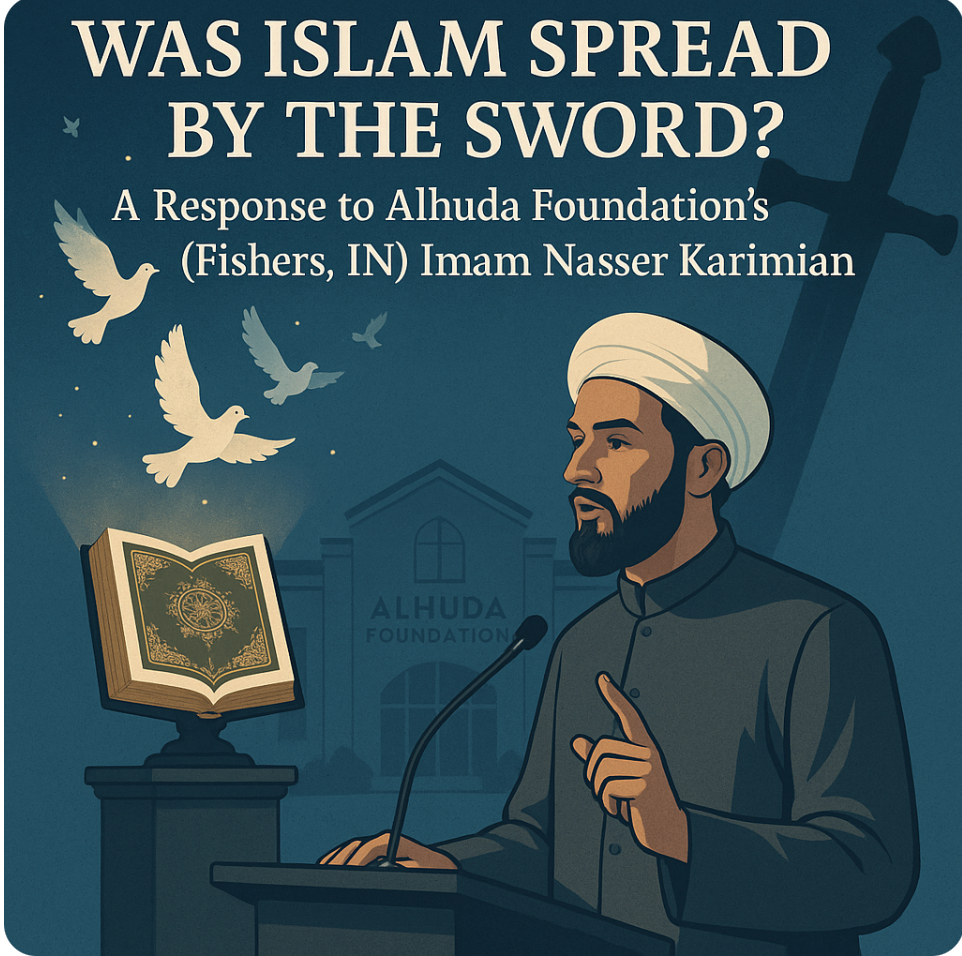

By Dr. Tim Orr
I recently watched a video by Nasser Karimian, the imam at the Alhuda Foundation in Fishers, IN, where he dismissed the idea that “Islam was spread by the sword” as both absurd and uninformed. While I can respect his desire to defend his faith, I believe his approach avoids the hard historical evidence that contradicts his narrative. It’s true that Western critics sometimes exaggerate the image of Islamic armies violently forcing every individual to convert, but the reality is more nuanced. Islam’s early expansion was indeed tied to military conquest, and its spread was facilitated by laws and political structures designed to give Islam a privileged position while marginalizing other faiths (Donner, 2010). Karimian’s framing makes it sound as though conversions across centuries happened solely due to the beauty of Islam’s message, which oversimplifies and romanticizes history. To have an honest conversation about religion and history, we must be willing to examine both the admirable and uncomfortable parts of our past.
Karimian also sets up a false dichotomy between the sword and persuasion, as if Islam’s expansion must have been entirely violent or entirely peaceful. The truth lies in a mixture of both. Military conquest created the conditions for Islamic dominance, which then allowed Islamic culture and religion to take root (Hoyland, 2014). Once Islamic empires were established, the laws they implemented often nudged non-Muslims toward conversion—not with a sword at their throat every day, but through sustained social and economic pressure (Lewis, 1993). By brushing aside this layered history, Karimian gives the impression that any mention of violence in Islam’s expansion is simply ignorance, which is not only historically inaccurate but dismissive of legitimate scholarship on the subject.
Historical Evidence of Islamic Conquest
Karimian appeals to Indonesia as a key example, arguing that its large Muslim population disproves the notion that Islam spread through violence. While it’s true that Islam reached Indonesia primarily through trade and cultural exchange, this single example cannot erase the mountains of evidence showing that Islam’s earliest and fastest expansion was military in nature. Within a century of Muhammad’s death, Islamic forces had taken control of vast regions spanning from Spain to India. These were not peaceful negotiations—they were campaigns of war, conquest, and subjugation (Kennedy, 2016). Cities such as Jerusalem and Damascus were taken by force, and the conquered peoples were quickly made subject to Islamic political and religious authority. The historical records, including Islamic sources like al-Tabari and al-Baladhuri, openly discuss these military campaigns without apology (al-Tabari, 1993/2015).
Moreover, the introduction of the jizya tax and the restrictions placed on non-Muslims under Islamic rule created an environment where conversion to Islam was often the only path to avoid social and economic disadvantage (Lewis, 1993). While Karimian scoffs at the idea of holding a sword over someone’s head indefinitely, the reality is that conversion does not require immediate violence when systemic pressures exist. Over generations, entire populations converted simply because life as a Muslim was easier, safer, and more socially accepted under Islamic rule. To deny this is not only ahistorical but also an attempt to whitewash the complexity of Islamic civilization’s rise.
The Nature of Coercion and Conversion
Karimian insists that “no one can hold a sword to someone’s neck for years,” as if the only kind of coercion is direct violence. But history shows that coercion often works through softer, more enduring means. Islamic law institutionalized a clear hierarchy: Muslims held full rights and privileges, while Jews and Christians were considered dhimmis, protected but subordinate peoples. They had to pay the jizya tax, could not bear arms, and were subject to certain social humiliations designed to remind them of their inferiority (Bat Ye’or, 2002). While these restrictions did not force immediate conversion, they created a social system where becoming Muslim was the path of least resistance.
Furthermore, Karimian’s argument completely ignores episodes of outright forced conversion that did occur throughout Islamic history. In regions like Persia, parts of India, and North Africa, non-Muslim populations faced waves of violence, destruction of temples or churches, and ultimatums to convert or face dire consequences (Cook, 2005). While not universal, these events undermine the overly neat narrative that Islam’s expansion was purely voluntary. Coercion can be slow and systemic or sudden and violent, but either way, the historical record shows that power and religion were tightly intertwined in the spread of Islam.
Modern Growth vs. Historical Spread
Karimian also points to the modern growth of Islam in Western countries as evidence that Islam must have been attractive in the past as well. While it is true that some people today freely choose Islam, this is not a meaningful comparison to the historical context of the 7th–10th centuries. Modern growth is largely fueled by high birth rates within Muslim families and immigration from Muslim-majority countries, rather than mass voluntary conversions in the West (Pew Research Center, 2017). In fact, studies suggest that conversion to Islam in places like the U.S. and Canada is a relatively small phenomenon compared to the growth by natural increase.
Moreover, using today’s religious freedom as a lens to reinterpret Islamic history is anachronistic. The early Islamic empires did not offer the kind of religious freedom we see in modern democracies. Non-Muslims could exist under Islamic rule, but only in a subordinate status, and their long-term survival depended on accepting these terms (Lewis, 1993). To claim that Islam’s historical spread mirrors its modern growth is misleading because the conditions, motives, and social structures involved are completely different. If Karimian wants to highlight the appeal of Islam, he should do so honestly without using modern freedoms as a way to rewrite the past.
Conclusion: A Call for Honest History
Karimian’s video tries to make the question of Islam’s spread seem like a simplistic, even laughable accusation, but the history is anything but simple. Yes, Islam has persuasive teachings, and yes, it spread peacefully in certain places like Southeast Asia. But it also expanded through conquest, legal pressure, and social stratification—realities that cannot be brushed aside with rhetorical thought experiments. Dismissing these facts doesn’t just weaken the credibility of the argument; it creates the impression that Muslims must deny history to defend their faith. I believe a better approach is to acknowledge both the noble and troubling chapters of Islamic history and engage in honest dialogue about them. Truth does not need to fear investigation. To pretend that force had no role in Islam’s spread is not only historically inaccurate but ultimately unconvincing to anyone willing to look at the evidence.
References
- al-Tabari. (1993/2015). The History of al-Tabari (Volumes I–XXXIX). SUNY Press.
- Bat Ye’or. (2002). The Decline of Eastern Christianity Under Islam: From Jihad to Dhimmitude. Associated University Presses.
- Cook, D. (2005). Understanding Jihad. University of California Press.
- Donner, F. M. (2010). Muhammad and the Believers: At the Origins of Islam. Harvard University Press.
- Hoyland, R. (2014). In God’s Path: The Arab Conquests and the Creation of an Islamic Empire. Oxford University Press.
- Kennedy, H. (2016). The Prophet and the Age of the Caliphates (3rd ed.). Routledge.
- Lewis, B. (1993). The Arabs in History. Oxford University Press.
- Pew Research Center. (2017). The Future of World Religions: Population Growth Projections, 2015-2060.
Who is Dr. Tim Orr?
Tim serves full-time with Crescent Project as the assistant director of the internship program and area coordinator, where he is also deeply involved in outreach across the UK. A scholar of Islam, Evangelical minister, conference speaker, and interfaith consultant, Tim brings over 30 years of experience in cross-cultural ministry. He holds six academic degrees, including a Doctor of Ministry from Liberty University and a Master’s in Islamic Studies from the Islamic College in London.
In addition to his ministry work, Tim is a research associate with the Congregations and Polarization Project at the Center for the Study of Religion and American Culture at Indiana University Indianapolis. His research interests include Islamic antisemitism, American Evangelicalism, and Islamic feminism. He has spoken at leading universities and mosques throughout the UK, including Oxford University, Imperial College London, and the University of Tehran. He has published in peer-reviewed Islamic academic journals. Tim is also the author of four books.
